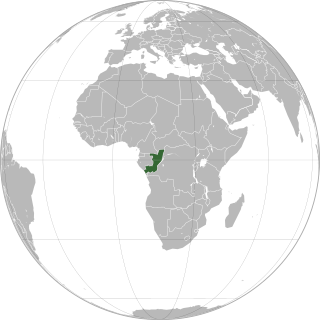More languages
More actions
Not to be confused with the Democratic Republic of the Congo, a neighbouring country
| Republic of the Congo République du Congo Republíki ya Kongó Repubilika ya Kôngo | |
|---|---|
 | |
| Capital and largest city | Brazzaville |
| Demonym(s) | Congolese |
| Government | Unitary semi-presidential republic |
• President | Denis Sassou Nguesso |
• Prime Minister | Anatole Collinet Makosso |
| Area | |
• Total | 342,000 km² |
| Population | |
• 2023 estimate | 5,677,493 |
The Republic of the Congo, also known as Congo-Brazzaville or Congo Republic, is an African country bordered by the Democratic Republic of the Congo, Angola, Gabon, Cameroon, and the Central African Republic.
History[edit | edit source]
The "Republic of the Congo" gets its start first off with a deal between the French and Teke/Tio Kingdom on the north bank of the Congo River.[1][2] This particular state establishes itself in the whirlwind of Central Africa's formal "decolonization" in response to Gaullist 1958 Referendum[3] and declaration of independence in 1960.[4] The original deal made with the Teke, or Anziku Kingdom, coalesced within these borders, around Brazzaville as its mouthpiece. The state, still "Francafrique" when it comes to currency[5] or "official language,"[4] arose within a broader constellation of Central African "Francophone" colonial possessions.
Throughout its colonized history, Congo-Brazzaville has served as a vital port for significant raw material wealth exports in copper and petroleum resources.[6][4]
References[edit | edit source]
- ↑ Oxford Dictionary of African Biography (2011).
- ↑ Jan Vansina (1973). The Tio Kingdom of the Middle Congo, 1880-1892: 'Preface' (pp. n18).
- ↑ "PROCLAMATION des resultats des votes emis par le peuple francais a l'occasion de sa consultation par voie de referendum, le 28 septembre 1958." (1958-09-28). Journal officiel de la République française. Retrieved 2024-07-03.
- ↑ 4.0 4.1 4.2 "Congo, Republic of the" (2021). CIA World Factbook.
- ↑ “The Bank of British West Africa (which became the Bank of West
Africa in 1957) and Barclays held between them the lion’s share of the
banking business of British West Africa, just as French West and
Equatorial Africa were shared out between the BAO and the BCA.”
Walter Rodney (1972). How Europe Underdeveloped Africa (p. 254). - ↑ “It should not be forgotten that outside of Southern Africa, there were
also significant mining operations during the colonial period. In North
Africa, foreign capital exploited natural resources of phosphates, oil,
lead, zinc, manganese and iron ore. In Guinea, Sierra Leone and
Liberia, there were important workings of gold, diamonds, iron ore and
bauxite. To all that should be added the tin of Nigeria, the gold and
manganese of Ghana, the gold and diamonds of Tanganyika, and the
copper of Uganda and Congo-Brazzaville.”
Walter Rodney (1972). How Europe Underdeveloped Africa (p. 280).


